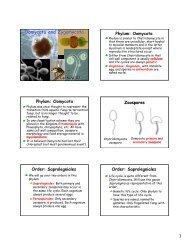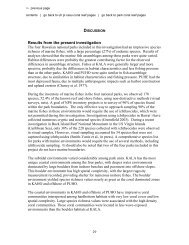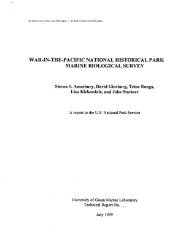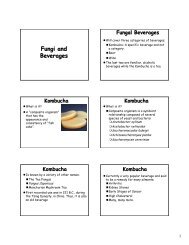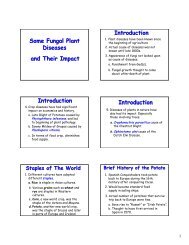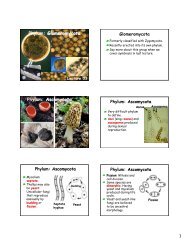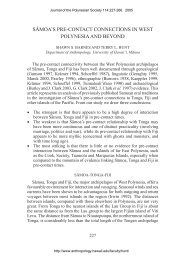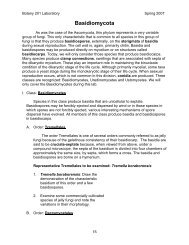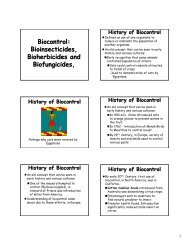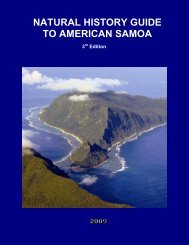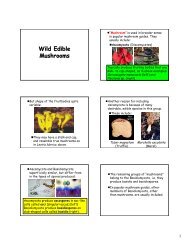american samoa - University of Hawaii at Manoa Botany Department
american samoa - University of Hawaii at Manoa Botany Department
american samoa - University of Hawaii at Manoa Botany Department
- No tags were found...
Create successful ePaper yourself
Turn your PDF publications into a flip-book with our unique Google optimized e-Paper software.
Long-term resource management activities associ<strong>at</strong>ed with the restor<strong>at</strong>ion <strong>of</strong> the Aoa wetlandshould include the seasonal monitoring <strong>of</strong> selected resource characteristics and periodic sitemaintenance.Resource MonitoringThe process <strong>of</strong> resource monitoring will involve completion <strong>of</strong> the following steps by ASEPA,ASCMP, or other ASG agency staff:• Prepare a field map <strong>of</strong> restor<strong>at</strong>ion and enhancement site from available digital files inthe American Samoa GIS.• Go to the restor<strong>at</strong>ion and enhancement site and collect inform<strong>at</strong>ion summarized on fieldmonitoring worksheet.• Upon return to <strong>of</strong>fice from the field, incorpor<strong>at</strong>e new sp<strong>at</strong>ial d<strong>at</strong>a, topographic fe<strong>at</strong>ures,and resource conditions within the American Samoa GIS as points, lines, or polygons.• When desired, expand <strong>at</strong>tribute tables for points, lines and polygons to enhance thedescription <strong>of</strong> resource characteristics and changes.• Make an annual evalu<strong>at</strong>ion <strong>of</strong> selected resource conditions th<strong>at</strong> analyzes theeffectiveness <strong>of</strong> the overall restor<strong>at</strong>ion and enhancement project.Long term monitoring <strong>of</strong> the Aoa wetland restor<strong>at</strong>ion project will require periodic examin<strong>at</strong>ions<strong>of</strong>:• General wetland/stream hydrology;• Stream channel modific<strong>at</strong>ions;• the survival <strong>of</strong> new mangrove propagules and riparian tree seedlings;• type and number <strong>of</strong> aqu<strong>at</strong>ic fish and invertebr<strong>at</strong>es in the Tapua Stream estuary; and,• changes in adjoining land uses.The types <strong>of</strong> inform<strong>at</strong>ion needed, monitoring frequency, monitoring loc<strong>at</strong>ions, and evalu<strong>at</strong>ionparameters are summarized in Table 4-8. A field work sheet or checklist, which can be used inthe field, is provided in Table 4-9.Future resource monitoring can be effectively performed through bi-annual site visits to theAoa wetland. This approach will enable comparisons during wet (December through March)and dry (April through November) seasons <strong>of</strong> the year. Additional visits should also take placeduring and/or following significant stormw<strong>at</strong>er events th<strong>at</strong> may be gener<strong>at</strong>ed from periods <strong>of</strong>significant rainfall.The availability <strong>of</strong> the American Samoa geographical inform<strong>at</strong>ion system enables theincorpor<strong>at</strong>ion <strong>of</strong> most all resource monitoring inform<strong>at</strong>ion within the GIS. Field d<strong>at</strong>a can besummarized in <strong>at</strong>tribute tables or d<strong>at</strong>abases. Digital photos can be linked to digital maps <strong>of</strong> therestor<strong>at</strong>ion site.Vehicular and pedestrian access to selected monitoring st<strong>at</strong>ions is largely dependent upon thecooper<strong>at</strong>ion and authoriz<strong>at</strong>ion <strong>of</strong> local residents and the Aoa Village Council. Assuming th<strong>at</strong>residents cooper<strong>at</strong>ively permit periodic access for long-term resource monitoring, monitoringshould take place along the following two stream segments (Figure 4-4):TABLE 4-8American Samoa Wetland/Stream Restor<strong>at</strong>ion and Enhancement PlanFebruary 2001, Aoa Wetland, Page 4-16



